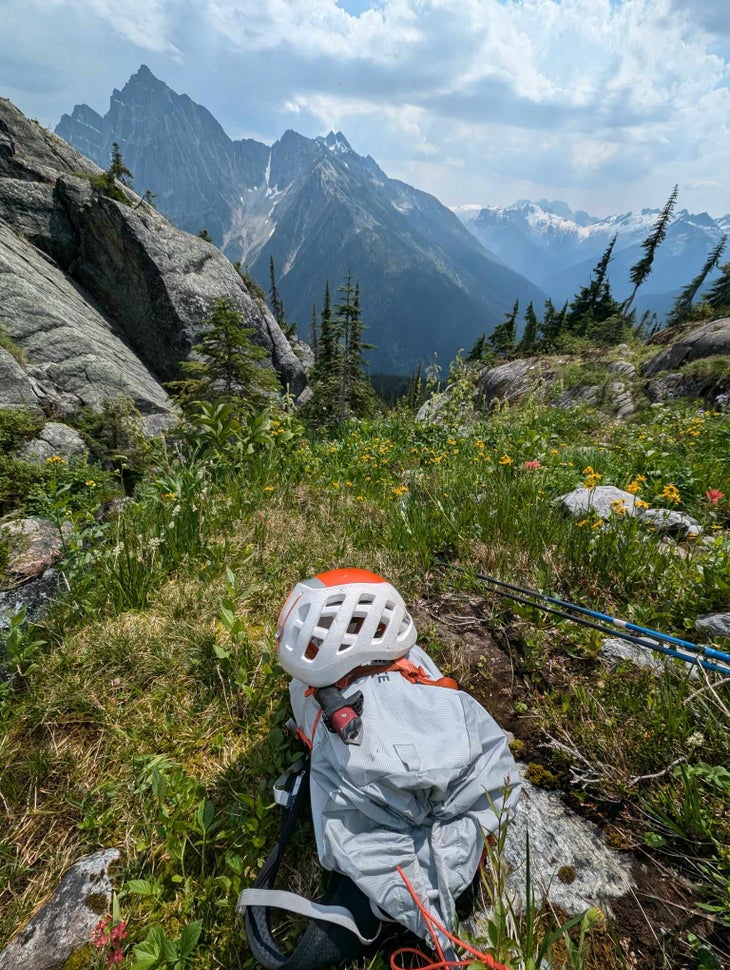Heading out the door? Read this article on the new Outside+ app available now on iOS devices for members! Download the app.

The Review
Climbing-pack enthusiasts took notice earlier this year when a certain (very famous) alpinist began posting photos of themselves climbing in Blue Ice’s new Stache UL pack instead of their primary sponsor’s 30-liter offering.
New sponsorship? I wondered. Just a damn good pack?
I ordered one up.
I tested the Stache UL on a variety of alpine-rock routes this summer and was consistently impressed with the thoughtfulness that Blue Ice put into each feature’s design. On a long, glacier-accessed 5.6 ridge in British Columbia’s Selkirk Mountains, the pack’s external elastic-mesh pocket allowed me easy access to a small water bottle and fast calories throughout the day. The pocket is not aligned vertically, but slanted toward the back panel so that I could access its contents while approaching and climbing without removing the pack. I prefer this style of external pocket over the new trend of adding running-vest-style pockets to climbing packs; while those flimsy pockets will snag on rock and easily tear, the Blue Ice system is more protected—though neither option is suitable for hauling.

The pack’s streamlined features kept my transitions brief during that day’s multiple glacier crossings, especially thanks to the smartly designed ice-axe attachments. The axe handle slides through the side compression strap, while the head gets threaded by a classic metal t-bar that has an elastic with cord-lock to cinch it tight. (Later that day, when lightning forced me off the ridge and down a particularly broken pocket glacier, I could easily grab my axe for a speck of security while leaping across a gaping bergschrund.) I’m actually shocked I haven’t seen this cord-lock design before: the t-bar is a classic attachment system, but, depending on the width of your axe head, it can give a loose, wobbly fit. Last December I walked nine hours into Patagonia’s Torre Valley with my partner’s Nomics clang clang clang-ing against each other every step of the way. The Stache UL’s cord-lock, on the other hand, ensures that any ice axe can fit on the pack… and then shut the hell up.

I also stuffed the Stache UL to its carrying limit while approaching the Northwest Ridge (5.8; ~900m) of Mt. MacDonald, forcing it to hold a tent, sleeping bag, pad, stove, and double rack, plus a 60-meter rope draped over the top. The unpadded, 2.5mm-wide waist belt certainly didn’t scream “comfort” during the multi-hour approach, nor did the equally unpadded shoulder straps, but I did finish the approach without any bruising or chafing.
The plus side to all this unpadded nonsense, of course, is that the pack climbs extremely well. I found the thin, air-permeable shoulder straps nearly unnoticeable while climbing 5.10+, particularly since they allow a full range of shoulder movement. Meanwhile, you can secure the side compression straps at one of two heights, allowing your pack to ride as low profile as possible while busting through thin squeezes or burly roofs.
After several months of testing I have experienced no holes or premature wear with this pack. I imagine this is because (1) I have not hauled it, (2) I’ve not climbed more than 100 meters of chimneys wearing it, and (3) the burly body fabric with UHMWPE is designed to hold fast against rough use. I expect to bring the Stache UL into the mountains for some time to come.
Buy the Stache UL (currently 25% off!) on Backcountry.com
Pros
- Provides a stable, quiet carry for two ice axes
- Secure, removable side compression straps
- Burly body fabric
- Elasticized side pocket is easy to access while approaching
- Breathable, low-profile shoulder straps
- Internal zipped pocket
Cons
- One size back length
- Cinch top closure is NOT waterproof. Keep in mind if climbing in areas with spindrift.
